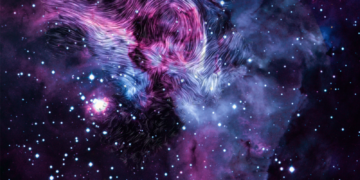Cosmology, the science of understanding the universe, constantly pushes the boundaries of our knowledge. The ΛCDM model, which has long served as the cornerstone of this field, describes the universe’s evolution and structure using concepts like cold dark matter (CDM) and the cosmological constant (Λ). However, a recent study has uncovered intriguing discrepancies in the growth of cosmic structures, raising questions that may lead to new physics.
A Crucial Discovery: Suppressed Cosmic Growth
The ΛCDM model has been remarkably successful in explaining phenomena like the accelerating expansion of the universe and the cosmic microwave background (CMB) radiation. However, recent data from galaxy clustering surveys like the Baryon Oscillation Spectroscopic Survey (BOSS) and the Dark Energy Survey Instrument (DESI) reveal a significant anomaly: cosmic structures are growing more slowly than the model predicts.
This suppression of structure growth, known as the σ8 tension, contradicts the results from CMB data, creating a puzzle for scientists. According to Dr. Shi-Fan Chen from the Institute for Advanced Study, this tension is not merely a statistical fluke. The odds of it being random are 1 in 300,000. Such a strong deviation suggests either unknown systematics in the data or entirely new physics.
What Is Cosmic Structure Growth?
Cosmic structure growth refers to the way matter in the universe clumps together over time to form galaxies, galaxy clusters, and larger structures. Gravity plays a pivotal role, pulling matter together while dark energy counteracts this process by accelerating the universe’s expansion.
The standard ΛCDM model predicts how these structures should evolve over billions of years. However, the new findings suggest a suppression in this growth during the later stages of the universe’s history. This suppression was identified through analyses of galaxy distributions and their cross-correlations with CMB lensing data. According to the researchers, this discrepancy is most pronounced in the current epoch, where dark energy dominates.
The Key Anomalies and Their Implications
- The Hubble Tension
- The Hubble tension refers to the disagreement between local measurements of the universe’s expansion rate (Hubble constant) and those derived from the CMB. This discrepancy has persisted despite increasingly precise data.
- The study reaffirmed the Hubble constant values obtained from the CMB, but these values clash with local observations, suggesting the need for alternative explanations.
- The σ8 Tension
- This tension arises from the slower-than-expected growth of cosmic structures. The study found a 4.5σ disagreement between structure growth observed in galaxy clustering data and predictions based on early universe conditions.
- According to Prof. Mikhail Ivanov from MIT, this suppressed growth challenges our understanding of how dark matter and dark energy influence the universe.
- Dynamical Dark Energy?
- While some theories suggest that dark energy could evolve over time (dynamical dark energy), this study found no strong evidence for such behavior. Instead, the data aligns more closely with dark energy behaving as a cosmological constant.
Is New Physics on the Horizon?
The observed suppression of structure growth raises the tantalizing possibility of new physics. Several hypotheses are being explored:
- Non-Standard Dark Matter
- Some scientists speculate that the nature of dark matter itself might explain the anomaly. For example, axionic dark matter or dark matter that interacts with baryons could alter the way cosmic structures form.
- “If this signal survives scrutiny, non-standard dark matter candidates could provide answers,” said Lukas Wenzl, a co-author of the study.
- Interactions Between Dark Energy and Dark Matter
- Another possibility is that dark energy and dark matter interact in ways not currently understood, influencing cosmic growth rates.
- Systematic Errors in Data
- While the results are compelling, the researchers emphasize the need for caution. Unknown systematics in the data or observational errors could also contribute to the discrepancies.
Why This Matters for Cosmology
The implications of this study are profound. If these findings hold up under further scrutiny, they could challenge one of the most robust models in cosmology. The ΛCDM model has been a reliable framework for decades, but its inability to fully explain these anomalies suggests that our understanding of the universe remains incomplete.
The study also highlights the importance of collaboration and comprehensive datasets. By combining data from sources like BOSS and Planck CMB maps, the researchers were able to identify patterns that single datasets might miss.
The Role of Future Observations
The next decade promises to be transformative for cosmology. Upcoming galaxy surveys and missions like the Euclid satellite and the Vera C. Rubin Observatory will provide even more detailed data on the universe’s large-scale structure. These observations will help confirm or refute the findings of this study and may reveal additional anomalies.
In addition to surveys, advancements in theoretical models will play a crucial role. By exploring new physics scenarios, scientists aim to bridge the gap between observations and theoretical predictions.
What Can We Learn?
This study serves as a reminder that science is an evolving process. The suppression of cosmic structure growth challenges our current models but also opens the door to new discoveries. Whether it’s uncovering new forms of dark matter or revising the nature of dark energy, the quest to understand the cosmos continues to inspire.
Conclusion
The suppression of cosmic structure growth is more than just an anomaly; it’s an invitation to rethink our understanding of the universe. As researchers delve deeper into these tensions, they may uncover new physics that reshapes cosmology. For now, this study serves as a milestone, highlighting the complexity and beauty of the cosmos. The universe, it seems, still holds many secrets waiting to be unraveled.
Reference:
Suppression without Thawing: Constraining Structure Formation and Dark Energy with Galaxy Clustering



















